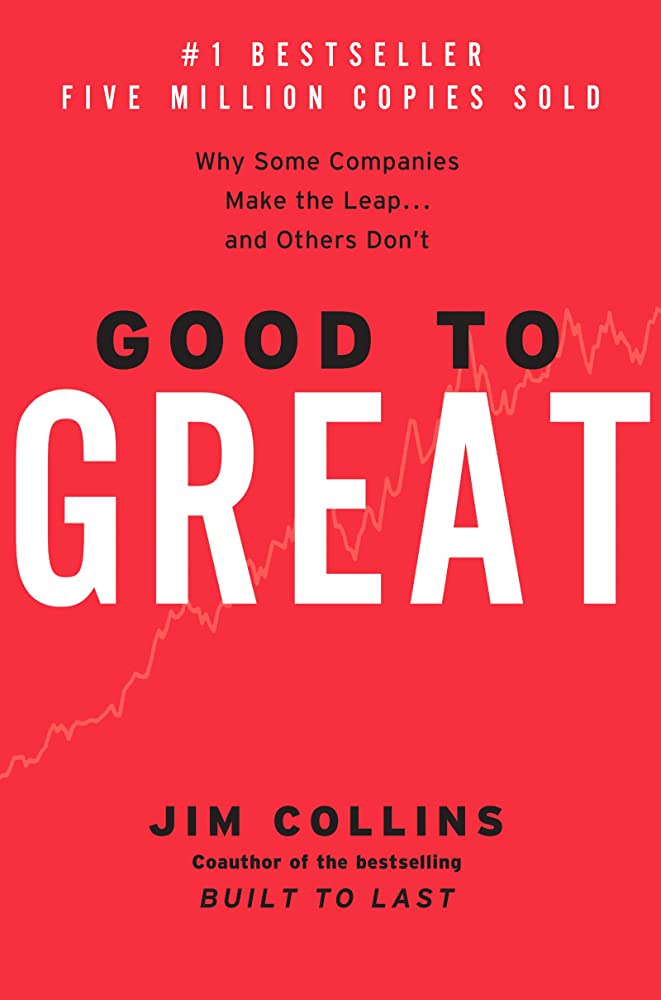Good to Great
RATING


Jim Collins undertakes the task of clarifying what it takes for a company to transition from simply being good to truly being great. The companies that he analyzes are the ones that have exceeded the market in terms of financial performance for a number of years, finding success after implementing a number of characteristics that they embody to a much greater extent than their competitors. Centered upon six topics, Collins illustrates through observation, research, and careful analysis what characteristics have been key to the success of 11 companies from 1965 to 1995.
- Level 5 Leadership
- First Who…Then What
- Confront the Brutal Facts
- Hedgehog Concept
- Culture of Discipline
- Technology Accelerators
Tackling these concepts in regards to the companies, Collins looks to the companies and depicts how they have taken and applied these concepts to heart. Through his explanation, readers can realize how these concepts have driven success, and how they can be applied within their own business, professional, or personal lives.
Collins uses a range of concepts in Good to Great, but they all point to people as being the real reason behind great companies. Level 5 leaders, talented employees, extraordinary companywide effort – there is a constant emphasis of people as being the core reason why companies find success. We wholly agree that people are at the core of why customers continue to return and business grows; people create the experience that customers come to love and convey to others.
Clarity in research books is hard to come by, but Collins makes it simpler with the inclusion of parallels that bridge his concepts with realistic situations. Most elegantly stated – using the comparison with a flywheel – a business is shown to have great inertia that requires the right elements – namely disciplined people and thought – before it can begin moving forward towards greatness. The book itself is well-researched and provides a comprehensive glimpse into the companies that grew from good to great over the years.
An issue that we found within the book was how these characteristics were viewed through the comparison of the example companies and their competitors. Instead, the book should have focused on the characteristics themselves and how they have improved the companies that utilized them. In other words, we were looking for characteristics and their effectiveness in making companies better. In hindsight, it would have served well to target the characteristics rather than the companies because, with several of these companies now dissolved or struggling, it draws questions as to whether it the qualities truly are able to drive success. Longevity of the concept is also an issue because we cannot say for sure whether these characteristics or outside factors caused their decline. We also were hoping to see a counter viewpoint presented within the book that would give us an idea of what could disprove the author’s findings. Having this information and then addressing it formally would clarify the reliability of the findings and present how it would stand against criticism.
The Challenge:
Built to Last, the defining management study of the nineties, showed how great companies triumph over time and how long-term sustained performance can be engineered into the DNA of an enterprise from the verybeginning.
But what about the company that is not born with great DNA? How can good companies, mediocre companies, even bad companies achieve enduring greatness?
The Study:
For years, this question preyed on the mind of Jim Collins. Are there companies that defy gravity and convert long-term mediocrity or worse into long-term superiority? And if so, what are the universal distinguishing characteristics that cause a company to go from good to great?
The Standards:
Using tough benchmarks, Collins and his research team identified a set of elite companies that made the leap to great results and sustained those results for at least fifteen years. How great? After the leap, the good-to-great companies generated cumulative stock returns that beat the general stock market by an average of seven times in fifteen years, better than twice the results delivered by a composite index of the world’s greatest companies, including Coca-Cola, Intel, General Electric, and Merck.
The Comparisons:
The research team contrasted the good-to-great companies with a carefully selected set of comparison companies that failed to make the leap from good to great. What was different? Why did one set of companies become truly great performers while the other set remained only good?
Over five years, the team analyzed the histories of all twenty-eight companies in the study. After sifting through mountains of data and thousands of pages of interviews, Collins and his crew discovered the key determinants of greatness — why some companies make the leap and others don’t.
The Findings:
The findings of the Good to Great study will surprise many readers and shed light on virtually every area of management strategy and practice. The findings include:
- Level 5 Leaders: The research team was shocked to discover the type of leadership required to achieve greatness.
- The Hedgehog Concept: (Simplicity within the Three Circles): To go from good to great requires transcending the curse of competence.
- A Culture of Discipline: When you combine a culture of discipline with an ethic of entrepreneurship, you get the magical alchemy of great results. Technology Accelerators: Good-to-great companies think differently about the role of technology.
- The Flywheel and the Doom Loop: Those who launch radical change programs and wrenching restructurings will almost certainly fail to make the leap.
“Some of the key concepts discerned in the study,” comments Jim Collins, “fly in the face of our modern business culture and will, quite frankly, upset some people.”
Perhaps, but who can afford to ignore these findings?
Good to Great is written with the aim of appealing to heads of companies. These are individuals who have the ability to alter their company as a whole, and it is essentially only these individuals who can fully apply the concepts that Collins conveys. To a lesser extent, managers and those overseeing other employees would gather some benefit from understanding the concepts, but their actual application would be limited due to their lack of control. Ideas are conveyed in such a manner that they are open to interpretation, making it difficult to definitively say how the concepts can be applied in a company. For this reason, we recommend that this be used as a framework for understanding while full application of the material is done in conjunction with books such as The Agenda. There is a cautionary note to be taken here seeing as how the companies analyzed do not always continue to do well, nor is this solely for the banking industry. Circuit City is one of the companies that has been phased out, and it should be noted that this book will provide case studies and qualities of the companies without promising success.

Good to Great is a well-researched book that analyzes what gives companies the ability to thrive and succeed. The book itself is primarily a compilation of case studies that supports a general thesis around what central qualities drive business growth, and accordingly it is marked as one of our research reviews. The book itself is very broad in terms of the company characteristics it identifies, leaving them open to interpretation. A lack of specific application prevents us from claiming that it covers tactical application of the topics.
See content on this topic

Sales training for front line along with basic development and coaching principles for line management.
Understanding how leaders must evolve with relation to the evolution of business models, new management models, and the significant changes to the workforce with Digital Natives now making up more than 50% of the workforce globally.
Understand the theory and mechanics of developing and managing a customer-centric and experience-driven corporate culture that is consistent and stable and includes elements of Employee Experience (EX) and Employee Relationship Management (ERM).
Understanding the evolution of leadership styles, management models, organizational structures, performance measurement and guiding change in the evolution of business models from product-centric to customer-centric and even relationship-centric.
Understand how to manage both internal and external digital transformation while considering the landscape for digital business models and the effect on traditional business models. Understanding organizational readiness for transformation and the role of corporate culture in managing transformations.
The changes in consumer behavior, employee behavior, and the evolution of business models in the digital age cause significant difficulties and imperatives for leaders who must develop new skills and evolve their leadership styles to be effective in this fast changing, challenging, and competitive environment.
Understanding how leaders must evolve with relation to the evolution of business models, new management models, and the significant changes to the workforce with Digital Natives now making up more than 50% of the workforce globally.
Understand how to manage both internal and external digital transformation while considering the landscape for digital business models and the effect on traditional business models. Understanding organizational readiness for transformation and the role of corporate culture in managing transformations.
The changes in consumer behavior, employee behavior, and the evolution of business models in the digital age cause significant difficulties and imperatives for leaders who must develop new skills and evolve their leadership styles to be effective in this fast changing, challenging, and competitive environment.
Understanding how to design & manage change/transformation programs in organizations of different sizes. This course will help any size team or organization to better deal with change & transformation on any scale.




 Copy Link
Copy Link
 E-mail
E-mail
 LinkedIn
LinkedIn
 Facebook
Facebook
 Telegram
Telegram
 WhatsApp
WhatsApp
















 Go Back
Go Back
Leave a Reply
You must be logged in to post a comment.